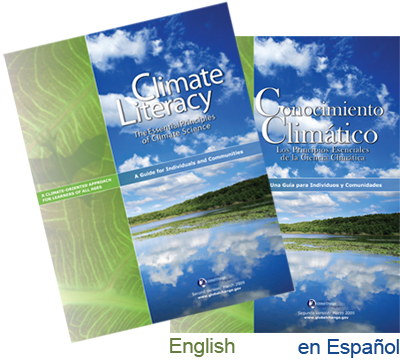
Chapter 4 of Climate Smart & Energy Wise reviews the essential principles of climate change as laid out in the Climate Literacy Framework The chapter also highlights many of the high-quality online resources—learning activities, visualizations, videos, and the like—that are available from the CLEAN collection.
The roots of these resources go back more than a decade. And therein lies a tale or two.
In 2004, there was essentially no funding for climate education through federal grants. The EPA’s “Global Warming” website for students and teachers (now updated as Climate Change for Kids) was not allowed to be refreshed per an order from the administration at the time. Scientists (such as NASA's James Hansen) were routinely censored and censured for trying to raise concerns about the implications of human-driven alterations to the climate system. At one point that year, while I was at NOAA’s Paleoclimatology program, the White House attempted to block the release of our Abrupt Climate Change website....until the New York Times asked the White House for comment, and then the website went up right away.
Given all this, it is perhaps not surprising that comprehensive coverage of climate change was lacking in the classroom. Few state science education standards included coverage of human impacts on the climate and environment. Even if the standards were in place, teachers were not getting the background and professional development necessary to teach the topic effectively. Science textbooks at the time did not lend much support, as they tended to skim over climate change or skip the topic all together. As a result, denial, doubt, and confusion were widespread.
In 2005, I attended an Earth science education meeting in Florida. While Hurricane Dennis churned toward the panhandle, I met Frank Niepold who was about to start a job at NOAA focusing on climate education. We discussed the idea of developing a framework for educators that would lay out the information necessary for students to become “climate literate”—that is, to make informed climate-related decisions. We also discussed expanding the small digital library collection of high quality climate change education resources that I had gathered through a small exploratory grant.
The inspiration for a climate literacy framework came from the Ocean Literacy work developed by NOAA, National Geographic Society, and others a few years earlier. The need for a similar framework for climate change was obvious—much of society had a fundamental lack of understanding regarding climate change. It took us several years to develop the Climate Literacy Framework, but in 2009 the current version, reviewed and endorsed by the US Global Change Research Program, was released, and that helped set the stage for the CLEAN project.
Funded by an NSF grant, CLEAN used the Climate Literacy Framework (and later the Energy Literacy companion framework) to identify rich, scientifically accurate resources with strong pedagogical potential. To do this, many thousands of online materials were examined to find those that met the quality standards and best fit with the framework. CLEAN—whose resources are now incorporated into NOAA’s climate.gov website—currently contains more than 500 resources that can be searched by resource type, key concepts, and grade level.
Chapter 4 of Climate Smart & Energy Wise prominently features these labors of the past 10 years—the climate framework and CLEAN, as well as links to relevant Next Generation Science Standards. Each of the seven Essential Principles of Climate Literacy, summarized below, are examined in detail through the lens of where and how to teach them well:
1. The sun is the primary source of energy for Earth’s climate system.
2. Climate is regulated by complex interactions among components of the Earth system.
3. Life on Earth depends on, is shaped by, and affects climate.
4. Climate varies over space and time through both natural and human processes.
5. Our understanding of the climate system is improved through observation, theoretical studies, and modeling.
6. Human activities are impacting the climate system.
7. Climate change will have consequences for the Earth system and human lives.
The often-overlooked guiding principle for informed climate decisions— that humans can take actions to reduce climate change and its impacts—is also examined in terms of how to teach it and what resources are most appropriate.
This chapter, as well as the one before it, focuses on where climate and energy tie to learning standards to help spark ideas and conversations on how and where to teach these long neglected yet vital topics in the curriculum. For example, suggestions are offered on how “doing the math” related to the essential principles adds depth to learning the science covered in the Next Generation Science Standards, connecting the learning to related Common Core State Standards for mathematics and language arts.
For each essential principle, the chapter calls out a few resources from the CLEAN collection and explains common “missed conceptions” that can trip up learning. Climate and related topics are extremely complex and often non-intuitive, so it is easy for students to get confused.
The goal of Chapter 4 is to provide educators and others interested in helping increase climate literacy with a set of tools and simple directions on how to navigate the realm of climate confusion, which is sometimes naturally occurring and sometimes deliberately promoted, and to develop learning pathways that clarify the basic causes, effects, risks and potential responses to human-induced climate change.
